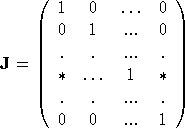
|
Рефератырусскому языку полиграфия хозяйство |
On a decomposition of an element of a free metabelian group as a productof primitive elementsOn a decomposition of an element of a free metabelian group as a productof primitive elementsOn a decomposition of an element of a free metabelian group as a productof primitive elementsE.G. Smirnova, Omsk State University, Mathematical Department 1. IntroductionLet G=Fn/V be a free in some variety
group of rank n. An element Note that |g|pr is invariant under action of Aut G. Thus this notion can be useful for solving of the automorphism problem for G. This note was written under guideness of professor V. A. Roman'kov. It was supported by RFFI grant 95-01-00513. 2. Presentation of elements of a free abelian group of rank n as a product of primitive elementsLet An be a free abelian group of
rank n with a basis a1,a2,...,an. Any element
Every such element is in one to one
correspondence with a vector Лемма 1. An element Доказательство. Let Note that every non unimodular
vector Предложение 1. Every element Доказательсво. Let c=a1k1...ankn for some basis
a1,...an of An. If g.c.m.(k1,...,kn)=1, then c is primitive by Lemma 1. If Corollary.It follows that |An|pr=2
for 3. Decomposition of elements of the derived subgroup of a free metabelian group of rank 2 as a product of primitive onesLet
The action in the module M'2 is
determined as
Note that for (u,g)=ugu-1g-1=u1-g. Any automorphism
Since M'2 is a characteristic
subgroup,
Consider an automorphism
By a Bachmuth's theorem from [1]
Consider a primitive element of the
form ux,
Using elementary transformations we can find a IA-automorphism with a first row of the form(1). Then by mentioned above Bachmuth's theorem
In particular the elements of type
u1-xx, u1-yy, Предложение 2. Every element of the derived subgroup of a free metabelian group M2 can be presented as a product of not more then three primitive elements. Доказательство. Every element
Thus,
A commutator
The last commutator in (3) can be
added to first one in (2). We get 4. A decomposition of an element of a free metabelian group of rank 2 as a product of primitive elementsFor further reasonings we need the
following fact: any primitive element The similar assertions are valid for
any rank Предложение 3. Any element of group M2 can be presented as a product of not more then four primitive elements. Доказательство. At first consider the elements in
form
and so as before
Obviously, two first elements above are primitive. Denote them as p1, p2. Finally, we have
If Further we have the expansion
The element w(v1xk1yl1) can be presented as a product of not more then three primitive elements. We have a product of not more then four primitive elements in the general case. 5. A decomposition of elements of a
free metabelian group of rank Consider a free metabelian group
Mn=<x1,...,xn> of rank Предложение 4. Any element Доказательсво. It is well-known [2], that M'n as
a module is generated by all commutators
Separate the commutators from (4) into three groups in the next way. 1) 2) 3) And the third set consists of the
commutator Consider an automorphism of Mn, defining by the following map:
The map
and hence, det Jk=1. Since element
[x1-1x2-1x3-1]. =p1p2p3p4 a product of four primitive elements. Note that the last primitive element p4=x1-1x2-1x3-1 can be arbitrary. Предложение 5. Any element of a free metabelian group Mn can be presented as a product of not more then four primitive elements. Доказательство. Case 1. Consider an element An element from derived subgroup can be presented as a product of not more then four primitive elements with a fixed one of them:
Then Case 2. If Список литературы Bachmuth S. Automorphisms of free metabelian groups // Trans.Amer.Math.Soc. 1965. V.118. P. 93-104. Линдон Р., Шупп П. Комбинаторная теория групп. М.: Мир, 1980. Для подготовки данной работы были использованы материалы с сайта http://www.omsu.omskreg.ru/ |
|
 ,
,